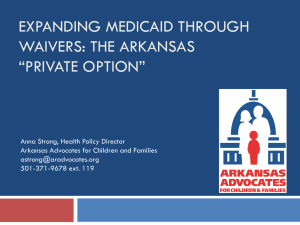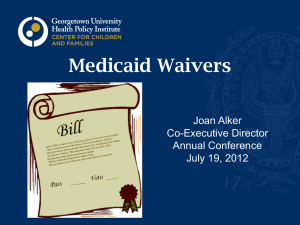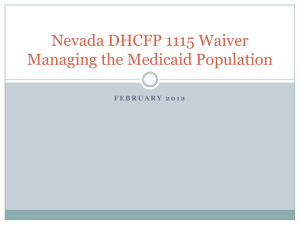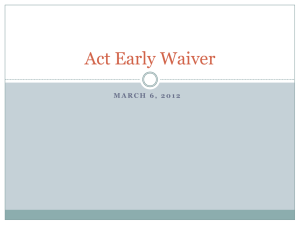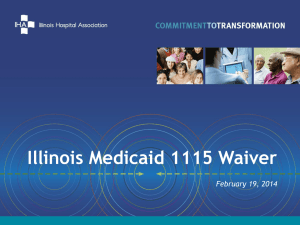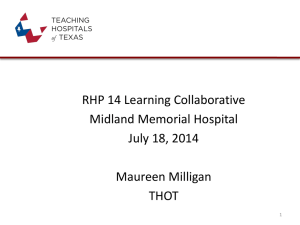Waivers_for_aaa_Conference_July_2011
advertisement
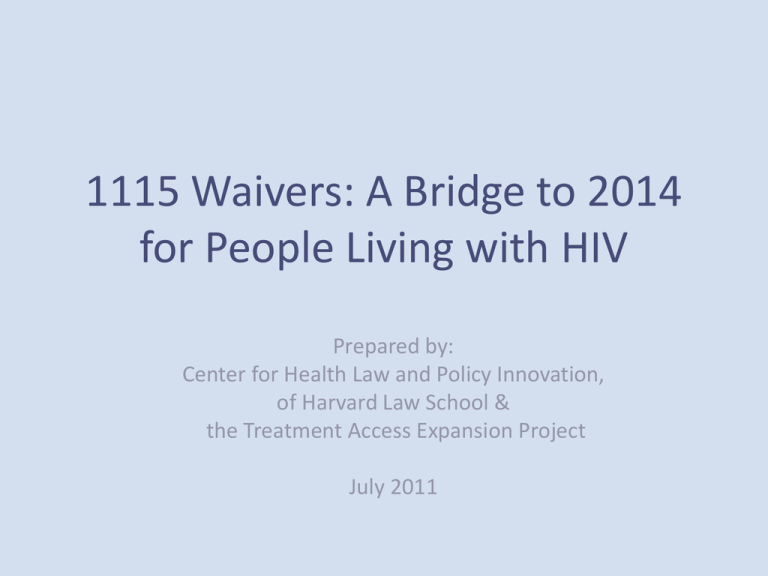
1115 Waivers: A Bridge to 2014 for People Living with HIV Prepared by: Center for Health Law and Policy Innovation, of Harvard Law School & the Treatment Access Expansion Project July 2011 Presentation Outline • Part 1: Background on 1115 Waivers and How They Can Help Your State • Part 2: Centers for Medicare and Medicaid (CMS) Guidance • Part 3: Next Steps 1115 Waivers and the National HIV/AIDS Strategy The Federal Implementation Plan calls on Centers for Medicare and Medicaid Services (CMS) to: “promote and support the development and expedient review of Medicaid 1115 waivers to allow States to expand their Medicaid programs to cover pre-disabled people living with HIV.” 3 Part 1 What Is an 1115 Waiver and How Will It Help My State? 1115 Waiver = A “Demonstration Project” to Expand Coverage States have flexibility in designing Medicaid programs, but have to follow federal laws • E.g., categories of eligibility • E.g., benefits package • E.g., statewideness Section 1115 of Social Security Act says that Secretary of HHS can waive federal requirements • “experimental, pilot, or demonstration project[s] which,” in her judgment, are “likely to assist in promoting the objectives of [the Act]” Traditionally, successful waivers must demonstrate “budget neutrality” • Federal Costs w/ Waiver ≤ Federal Costs w/out Waiver Federal & state governments share coverage costs 1115 waivers are timelimited • Federal share (FMAP) varies by state and is based on per capita income • Must be re-approved after a five-year period Examples of 1115 Waivers to Expand Medicaid Coverage Response to public health emergency Cost-effective early intervention to people living with HIV Examples of 1115 Waivers Expansion to childless adults How Will an 1115 Waiver Help My State? A Waiver Will Help Address the AIDS Drug Assistance Program (ADAP) Crisis • Waiting lists for ADAP have grown to over 8,000 individuals nationwide • Ryan White care, treatment and service demands far outpace current funding • The majority of ADAP beneficiaries in every state would be eligible for Medicaid through a waiver How Will an 1115 Waiver Help My State? A Waiver Will Allow States to Leverage Federal Matching Funds • Because Medicaid is funded jointly by the federal government and states, moving people from ADAP to Medicaid means matching federal $$ Example: North Carolina State Response 1115 State/Federal Response $28 million out of state budget $28 million from state would to address ADAP crisis leverage $51.3 million in federal matching funds (at 64.71% FMAP) with an 1115 waiver How Will an 1115 Waiver Help My State? A Waiver Will Provide CostEffective Early Intervention • Reduces transmission rates • Reduces costly hospitalizations and other costs of late intervention • Reduces expenditures by disproportionate share hospitals • Reduces Social Security disability costs • Increases productivity and employment How Will an 1115 Waiver Help My State? 1115 Waiver Is a Test Run for the 2014 Medicaid Expansion • In 2014, most people up to 133% FPL will be eligible for Medicaid • Incremental expansion allows for a smooth transition to full Medicaid expansion • Phases-in integration of providers and consumers • Provides opportunity to effectively integrate Ryan White model of care Massachusetts ADAP: How Many Are Covered and at What Cost? Year Enrolled State Cost Federal Cost Total Cost (including rebates) FY02 2301 $ 699,700 $ 7,816,675 FY03 2716 $ 1,011,873 $ 8,491,468 $ 10,703,342 FY04 4399 $ 4,635,821 $ 9,352,017 $ 15,887,838 FY05 4738 $ 4,216,175 $ 11,591,967 $ 17,708,142 FY06 4668 $ 4,216,175 $ 7,427,022 $ 13,543,197 FY07 5141 $ 1,958,523 $ 10,726,583 $ 14,585,106 FY08 5601 $ 1,958,523 $ 11,733,010 $ 15,591,533 FY09 5882 $ 1,958,523 $ 12,640,882 $ 16,099,405 $ 9,716,375 Massachusetts ADAP: Expenditures by Category Year Full Pay Co-Pay Premiums FY02 $ 7,947,832 $ 648,030 $ 1,120,512 FY03 $ 7,961,862 $ 963,205 $ 1,778,272 FY04 $11,174,879 $ 1,553,758 $ 3,159,200 FY05 $ 9,756,201 $ 1,839,807 $ 6,112,132 FY06 $ 4,634,683 $ 1,893,206 $ 7,015,306 FY07 $ 4,147,713 $ 2,071,118 $ 8,366,273 FY08 $ 4,184,279 $ 2,083,431 $ 9,323,821 FY09 $ 4,695,780 $ 2,567,789 $ 8,835,835 Massachusetts ADAP: Eligibility (Sept. 2009) Income Enrolled Percentage < 100% FPL 2711 52% 100 - 200% FPL 1251 24% 200 - 300% FPL 618 12% 300 - 400% FPL 402 8% > 400% FPL 249 5% 13 Massachusetts Medicaid HIV Expansion Line Item Budget Allocation • FY09 $16,591,488 • FY10 $18,078,571 (1,233 enrolled) • FY11 $18,801,714 In addition, MA provides approximately $30M per year in funding to MA DPH to support a broad range of testing, care, treatment and prevention initiatives. 38% decrease in HIV incidence compared to 8% national increase (2005-08) Total viral suppression rate of 65% compared to 49% nationally (2006) Key Mass. Outcomes Adjusted death rate of 2% compared to 3.7% nationally (2008) AIDS diagnosis rate of 6.5 per 100K compared to 11.2 per 100K nationally (2008) 42% decrease in AIDS deaths compared to 24% decrease nationally (200208) Estimated Cost Saving Associated with HIV Investments Between 1999 and 2008… Estimated 4,085 cases averted Estimated lifetime medical costs of over $300K per person and over $1.2B saved Part 2 CMS Guidance: What Is It and How Will it Help My State? What is CMS Doing to “Promote and Support” 1115 Waivers? State Medicaid Director Letter • Guidance on several health care reform opportunities to expand access to care for people living with HIV and AIDS • 1115 waiver to cover pre-disabled people living with HIV and AIDS • Medicaid Health Home program for Medicaid enrollees with chronic conditions (including HIV and AIDS) • 1915 Home and Community Based Care waivers • “Money Follows the Person” program to Help People Living with HIV and AIDS transition from institutions to the community How Will the CMS Guidance Help States Put Together Successful Applications? Creative Ways to Demonstrate “Budget Neutrality” Waiver Population = “Pass Through” • The health care reform law permits states to immediately cover most individuals up to 133% of the federal poverty level rather than wait until 2014 • For the purposes of the waiver, covering pre-disabled people living with HIV is a way for a state to expand Medicaid early for this population How Will the CMS Guidance Help States Put Together Successful Applications? Creative Ways to Demonstrate “Budget Neutrality” Cost Avoidance • Providing early intervention to an individual living with HIV through the waiver is less costly than waiting for that person to become disabled • Early intervention reduces costly hospitalizations and other costs associated with disease progression Simplified Cost Avoidance • Factors in the number of AIDS cases averted due to expanded Medicaid coverage How Will the CMS Guidance Help States Put Together Successful Applications? Creative Ways to Demonstrate “Budget Neutrality” Disproportionate Share Hospital (DSH) Diversion “Unique Programmatic Savings” • States divert DSH funds to pay for uninsured individuals living with HIV/AIDS • E.g., implementation of a managed care service delivery model or a pharmacy discount program such as 340B 1115 Waiver Is Still a Heavy Lift in Most States Still need to allocate scarce state $$ to draw the federal match Difficult political environment for Medicaid State Medicaid offices are understaffed and underfunded Part 3 Next Steps What You Can Do… Start talking with state officials about the 1115 waiver • Meet with your state Medicaid office, Governor’s office and state legislators • Make sure you know what the application process is in your state (some states require legislative approval to apply for a waiver) Support introduction of a resolution in your state legislature, if needed • Commission a study to analyze costs and benefits of implementing a waiver • Commit Medicaid office to consider applying Use CMS as a resource • Contact Barbara Edwards, Director, Disabled and Elderly Health Program Group, or Vikki Wachino, Director, Children and Adults Health Program Group at (410) 786-5647 For More Information Treatment Access Expansion Project Taepusa.org Contact: Amy Killelea, akillelea@law.harvard.edu Dose of Change Doseofchange.org CMS, State Medicaid Director Letter https://www.cms.gov/SMDL/SMD/ 25
